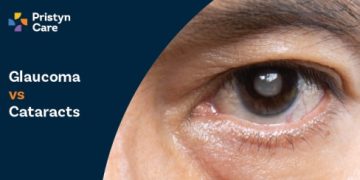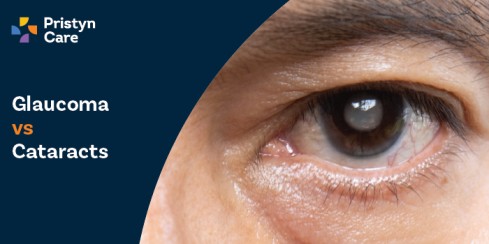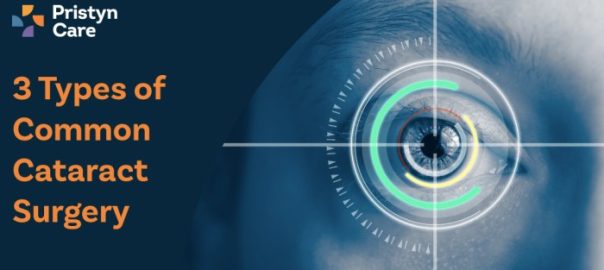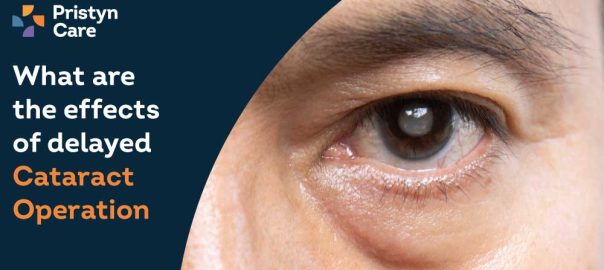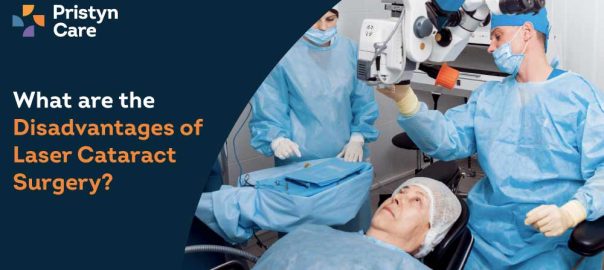![]() Views: 110
Views: 110
Glaucoma Vs Cataracts
Struggling to understand the difference between glaucoma and cataracts? You're not alone. Many people find it challenging to distinguish between these two common eye conditions. Both affect your vision, but they have distinct causes and treatments.
Dedicated Support at Every Step!
Our Doctors are available 24 hours a day, 7 days a week to help you!
Glaucoma is a group of eye conditions that damage the optic nerve, crucial for good vision. This damage is often caused by abnormally high pressure in your eye. On the other hand, cataracts involve the clouding of the lens, leading to a decrease in vision. It’s like looking through a foggy or dusty car windshield.
Things might seem blurry, hazy, or less colourful. Understanding these differences is key to managing and treating these conditions effectively. This blog will clarify these differences, offering you insights into how each affects your vision and what steps you can take to protect your eyesight as you age.
Table of Contents
What is Glaucoma?
Glaucoma is a group of eye conditions that damage the optic nerve, vital for vision. This damage often links to high pressure in the eye and can lead to vision loss if not treated.
Causes and Risk Factors
The exact cause of glaucoma is often unclear, but elevated pressure inside the eye (intraocular pressure) is a significant risk factor. Let’s explore some key factors:
- Age: Individuals over 60 are at higher risk.
- Ethnicity: African, Caribbean, and Asian heritage increase the risk.
- Family History: Having a family member with glaucoma increases your risk.
- Medical Conditions: Diabetes, heart disease, and high blood pressure can contribute.
- Eye Conditions: Severe eye injuries or certain surgeries can elevate risk.
Types of Glaucoma
There are several types of glaucoma, each affecting the eye differently:
- Open-Angle Glaucoma: The most common form, where the eye does not drain fluid as well as it should, causing pressure to build up slowly. This type often has no early symptoms.
- Angle-Closure Glaucoma: This type occurs when the iris bulges forward to narrow or block the drainage angle of the eye. Symptoms can appear suddenly and are severe, such as eye pain, headaches, and blurred vision.
- Normal-Tension Glaucoma: Here, optic nerve damage occurs despite normal eye pressure. The exact cause is unknown, making regular eye checks essential.
- Secondary Glaucoma: This type results from an injury or another eye condition, such as cataracts or eye tumours.
Symptoms and Early Warning Signs
Glaucoma is often called the "silent thief of sight" because it might not cause noticeable symptoms until significant damage has occurred. However, be vigilant for:
- Gradual loss of peripheral vision: Usually in both eyes.
- Tunnel vision: In advanced stages.
- Severe eye pain: Typically in acute cases of angle-closure glaucoma.
- Blurred vision: Especially if it occurs suddenly.
Diagnosis and Testing
Early detection plays a critical role in protecting your eyesight from glaucoma. Tests to diagnose glaucoma include:
- Eye pressure test (tonometry): Measures the pressure inside your eye.
- Visual field test: Checks for areas of vision loss.
- Optic nerve imaging: Assesses any damage or abnormality in your optic nerve.
- Angle examination: Examines if the angle where the iris meets the cornea is open or closed.
No Cost EMI, Hassle-free Insurance Approval
What are Cataracts?
Cataracts are a common eye condition where the lens of your eye becomes cloudy, making your vision blurry. This cloudiness can increase over time, severely impacting your ability to see clearly.
Causes and Risk Factors
Cataracts develop mainly due to ageing but other factors also play a role:
- Age: Most cataracts develop as a result of ageing.
- Genetics: Family history can increase your risk.
- Medical conditions: Diabetes and other health issues can contribute to their development.
- Lifestyle choices: Smoking and excessive alcohol consumption can accelerate cataract formation.
- UV radiation: Long-term exposure to sunlight can lead to cataracts.
Types of Cataracts
Cataracts can be classified based on their origin and the part of the lens they affect:
- Age-Related Cataracts: The most common type, which occurs as part of the ageing process.
- Congenital Cataracts: Some people are born with cataracts or develop them in childhood, often in both eyes. These may be genetic or associated with intrauterine infection or trauma.
- Secondary Cataracts: These develop as a result of other medical conditions, such as diabetes, or from exposure to toxic substances, certain drugs, or ultraviolet light.
- Traumatic Cataracts: These form after an injury to the eye.
Symptoms and Early Warning Signs
The symptoms of cataracts can vary depending on the type but generally include:
- Blurred vision: Seeing cloudy or dim vision as if looking through a fogged window.
- Glare sensitivity: Lights may appear too bright or halo around them.
- Fading colours: Colours look faded or yellowed.
- Double vision in one eye: You might see two images instead of one.
Diagnosis and Testing
Diagnosing cataracts involves a series of tests to check the health and clarity of your lens:
- Visual acuity test: This measures how well you see at various distances.
- Slit-lamp examination: The doctor uses a microscope to look at the structures at the front of your eye under intense light.
- Dilated eye exam: Drops are placed in your eyes to widen the pupils. This allows the doctor to see more of the lens and the back of the eye.
- Glare sensitivity: Tests how bright lights affect your vision.
Comparing Glaucoma and Cataracts
While both glaucoma and cataracts are eye conditions that can impair vision, their causes, symptoms, and treatment options differ significantly. Knowing these differences is crucial for effective management and treatment.
Differences in Causes
Glaucoma and cataracts stem from distinct causes:
- Glaucoma: This condition is primarily caused by an increase in intraocular pressure, which can damage the optic nerve. Factors such as age, ethnicity, family history, and certain medical conditions like diabetes and hypertension contribute to the risk.
- Cataracts: These develop mainly due to age-related changes in the lens of the eye, leading to clouding. Other causes include genetics, long-term exposure to UV light, diabetes, smoking, and eye injuries.
Variations in Symptoms
The symptoms of glaucoma and cataracts vary:
- Glaucoma: Often called the "silent thief of sight," glaucoma may not present noticeable symptoms until significant vision loss has occurred. Initial symptoms can include peripheral vision loss, blurred vision, and in acute cases, severe eye pain, nausea, and redness.
- Cataracts: Symptoms are usually more noticeable and include blurred or foggy vision, difficulty with vision at night, sensitivity to glare, double vision in one eye, and fading or yellowing of colours.
Treatment and Management
Effective management of glaucoma and cataracts is crucial to prevent vision loss and improve life quality. This section outlines the varied treatment options available for both conditions.
Treatment Options for Glaucoma
Glaucoma treatment focuses on lowering eye pressure to prevent damage to the optic nerve.
- Medications:
- Eye Drops: The first line of treatment usually involves eye drops that reduce eye pressure either by decreasing the amount of fluid the eye makes or by helping the fluid drain from the eye.
- Oral Medications: In cases where eye drops are insufficient, doctors may prescribe oral medications to further decrease eye pressure.
- Laser Therapy:
- Trabeculoplasty: This procedure is used for open-angle glaucoma and involves a laser that enhances the eye's drainage function to lower eye pressure.
- Iridotomy: For angle-closure glaucoma, this laser procedure creates a small hole in the iris, helping fluid flow to the drainage angle.
- Surgical Procedures:
- Trabeculectomy: This surgical procedure involves creating a new drainage path in the eye to ease fluid flow and reduce intraocular pressure.
- Glaucoma Implant Surgery: This involves placing a small device in the eye that helps fluid escape, thereby lowering eye pressure.
Treatment Options for Cataracts
Cataract treatment typically progresses from non-surgical methods to surgery as the condition worsens.
- Non-Surgical Interventions:
- Improved Lighting: Using brighter lights at home or work can help alleviate the symptoms of early cataracts.
- Visual Aids: High-power reading glasses and magnifiers can enhance visual clarity for those with cataracts.
- Surgical Removal:
- Phacoemulsification: The most common surgical method involves using ultrasound vibrations to dissolve the cloudy lens, which is then removed and replaced with a clear artificial lens.
- Extracapsular Cataract Extraction: This technique removes the cloudy lens in one piece and is typically reserved for advanced cataracts where phacoemulsification might not be possible.
- Post-Surgical Care:
- Eye Drops: Post-surgery, patients typically use eye drops to prevent infection and control eye pressure.
- Follow-up Exams: Regular follow-up exams are crucial to monitor the eye’s healing process and ensure the success of the surgery.
Living with Glaucoma and Cataracts
Living with glaucoma and cataracts involves making lifestyle adjustments and adhering to regular monitoring to manage symptoms and slow progression. Here’s how you can effectively manage these eye conditions through daily life and health strategies.
Lifestyle Adjustments and Home Care
- Improve Home Safety: To prevent falls and injuries, especially with vision impairment, ensure that your home is well-lit and free from trip hazards. Use non-slip mats and have handrails installed where necessary.
- Adjust Lighting: Increase lighting in your home to help with vision clarity. Use task lighting for activities like reading and cooking.
- Use Visual Aids: Employ tools such as magnifying glasses, high-contrast clocks, and phones with large buttons to help navigate daily tasks more easily.
- Protect Your Eyes: Wear sunglasses to protect your eyes from UV rays and safety eyewear to shield against wind and debris when outdoors.
- Healthy Diet: Eating a diet rich in fruits and vegetables, especially dark leafy greens, can help maintain eye health. Foods high in antioxidants like omega-3 fatty acids are also beneficial.
Regular Monitoring and Health Tips
- Routine Eye Examinations: Regular check-ups with an eye care professional are crucial to monitor the progression of glaucoma and cataracts and adjust treatment plans as needed.
- Monitor Vision Changes: Be vigilant about changes in your vision, such as increased blurring, loss of peripheral vision, or sudden eye pain. Report these to your doctor immediately.
- Follow Treatment Plans: Adhere strictly to any treatment regimens prescribed by your eye doctor, including taking medications and using eye drops as directed.
- Stay Active: Regular exercise can help reduce eye pressure, especially for those with glaucoma. Activities such as walking can be beneficial, but always consult with your doctor before starting any new exercise program.
- Manage Other Health Conditions: Keeping systemic health conditions like diabetes and hypertension under control can significantly impact the management of eye health.
Wrapping Up
In the battle between glaucoma and cataracts, knowledge is your best ally. Both conditions affect millions worldwide, yet they differ significantly in their impact and management. Glaucoma stealthily compromises the optic nerve, often without warning, necessitating proactive treatment to manage eye pressure. Cataracts cloud your vision more overtly, with surgical solutions offering a clear path to restored sight.
Regular eye exams are vital. They are your frontline defence in detecting changes early and adjusting treatment plans effectively. With timely intervention and the right care, you can continue to enjoy life's visual pleasures, even with glaucoma or cataracts. Stay informed, stay proactive, and keep looking forward to a brighter, clearer future.



